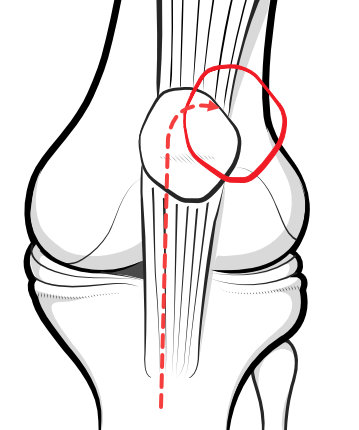The J-sign is when the kneecap 'pops out' (subluxes) to the outer side each time the knee moves into the fully straight position (terminal extension).
 Page updated March 2024 by Dr Sheila Strover (Clinical Editor)
Page updated March 2024 by Dr Sheila Strover (Clinical Editor)

What does a positive J-sign indicate?
The presence of a J-sign indicates that the trochlear groove of the femur, in which it runs, is not managing to constrain it as the knee goes into extension.
This may be because of a shallow groove at the upper end of the trochlea (trochlear dysplasia) or the patella may be positioned a bit high (patella alta), or some other structural problem may be present.
-
Quote from peer-reviewed paper:
"The J-sign on clinical examination is suggestive of patellar maltracking and potential instability." - [paper links to a video]
Citation: Hadidi O, Ellanti P, Lincoln M, Hogan N. The J-sign in patellar maltracking. BMJ Case Rep. 2018 Feb 14;2018:bcr2017222887. doi: 10.1136/bcr-2017-222887. PMID: 29444791; PMCID: PMC5847943.
Is a J-sign always accompanied by problems?
Some people exhibit a positive J-sign but do not complain of any symptoms.
-
Quote from peer-reviewed paper:
"....chronic recurrent patellar instability is difficult to treat and may involve a variety of underlying pathology...."
Citation: Beckert MW, Albright JC, Zavala J, Chang J, Albright JP. Clinical Accuracy of J-Sign Measurement Compared to Magnetic Resonance Imaging. Iowa Orthop J. 2016;36:94-7. PMID: 27528843; PMCID: PMC4910780.
See also -
- Patellar instability
- Patella alta
- Patellar brace
- Patellar dislocation
- Patellar subluxation
- Trochlear dysplasia
- TT-TG Distance
From the Experts -
- Expert view - The J-Sign - by Dr Lars Blønd (Knee Surgeon)